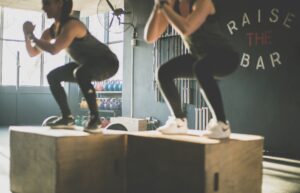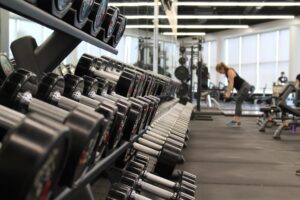
In spite of such reluctance to hit the gym, cyclists can really benefit by building stronger and more robust legs away from the bike. Whether due to confusion about what it actually is or uncertainty about the best exercise to strengthen the legs by incorporating strength training into your regular training programme, you won’t regret it, I promise.
Is Strength Training Good For Cyclists?
If you’re a cyclist, you know how much fun it is to ride your bike. But if you don’t have a lot of time on your hands. Strength training can be a great way to get better at cycling without having to spend more time on the bike.
Strength training itself is a form of resistance training, once we conquer that resistance, it will make us stronger which in turn improves cycling performance. Cycling is much about leg strength, so it would be logical to target those specific muscle groups away from the bike.
Stating the obvious, strength training, done well, improves maximum force production, which will increase your ability to exert more power, by generating more force for every turn of the pedal, you’ll be able to go faster for longer.
Needless to say, cycling consists of a singular action repeated over and over again. Too much of one movement can create overuse, and muscle imbalance leading to injuries.
Traditionally, competitive cyclists have raised concerns about whether strength training will increase their overall body mass. Yet, there is clear evidence that a lesser increase in muscle hypertrophy is achieved when strength training is performed simultaneously with endurance training. Combining strength training and endurance will certainly make you a dynamite on the road.
Best Leg Exercises for Cyclists
We’ve narrowed it down to the best exercise to either do at home or in the gym, with little to no equipment needed or you use weight if you’re up for the challenge. These exercises have been backed up by scientific evidence to prove the benefits it has on cycling performance.
Goblet Squat
Squats are the most effective strength exercises for cyclists because they target all muscles in the lower limb. The squat is a quadricep-dominant exercise, which is integral to a powerful pedal stroke. This is a great bilateral movement which works both legs simultaneously, which results in the ability to use heavier loads producing greater training stimulus.
How to do this:
Stand with your feet hip-width apart, with your toes angled slightly outward.
Hold the kettlebell or dumbbell in both hands at your chest with your elbow tucked in and ensure the goblet is positioned right on centred on your chest
Engage your core and look straight ahead. Drop down with hips and bend knees at a 90 angle into a squat. Go until things are nearly parallel to the ground, push through your feet to stand back up and repeat with another leg
Aim for around 4 sets of 8-10 reps.
Lunges
engage the quadriceps, hamstrings and glutes which are excellent all-round exercises for cyclists. This is a great unilateral exercise which trains both sides of the leg equally. This prevents overusing, and overtraining the dominant side of the leg, which helps correct muscle imbalances.
How to perform this:
Start by standing shoulder to shoulder apart
Take a step forward with your right leg so that your knee flexes at approximately 90 degrees and your left leg remains flat towards the floor
Hold this position then, and push off your front leg to return to the starting position
Aim for 3 sets of 10 is great
Romanian Deadlift
This alternative takes on a conventional deadlift which also strengthens all muscles in the posterior. More importantly, the Romanian deadlift relies on hinging around the hips, therefore, adding more tension and resulting in greater glutes and hamstring activation.
Stand with feet hip-width apart with a slight bend in your knees.
Hinge forward at the hip, while maintaining a straight posture, so you go down and stick your bum out. Go lower until you feel a slight stretch in your hamstring
Then immediately drive through your hips and hamstring until upright.
Glute bridge
This exercise targets the glutes and hamstring responsible for hip extension and explosive posterior chain movements. Because the glutes are the biggest muscle in the body, it is important you target them.
Lay down on your back, with your knee bent and feet planted on the ground
Raise your hips off the ground until your knee, hips and shoulder form a straight line
Squeeze your glutes as tight as you can while at the top position and hold for 3 seconds
Slowly return your hips lower into the original starting position
Box Jump

This is a great plyometric exercise which utilises fast twitch muscle and it can be an excellent way to enhance explosive power, and further develop strength through your lower body. Brains activate more muscle fibres in order to increase the efficiency and speed of muscle contraction ( Stretch – Shortening cycle)
Position yourself on a font-stable platform, ideally a soft plyo box.
Stand in front of the box with your feet shoulder-width apart
Then simply squat down, jump off, and repeat on the box.
To add difficulty, keep your arm beside your hips.
4 sets of 10 reps
Should I use my bodyweight or Free Weights?

This debate comes down to the goal you’re looking to achieve. Having said that, if you’re a complete beginner then I would suggest starting off by using your own body weight. Once you begin to make progress and feel comfortable, start introducing weights to your training.
Once more, If you’re short on time but still looking for a decent workout, then bodyweight can be an excellent choice. It requires minimal equipment making them accessible for cyclists regardless of ability. However, the major downside I’ve found is, that as you progress bodyweight exercise may become easier because your body adapts to the load. At that point, your progress will feel stagnant, and it can be challenging to progress beyond this.
Performing exercise with loaded weights (Dumbbell, Barbell etc.) will increase your absolute strength. Again, you can target specific muscle groups in isolation when helping correct any muscle imbalances.
When Should I Rest?
Strength training generates substantial fatigue. Depending on the intensity of your workout and the phase in the programme, I would advise you to allow a minimum of 2 days to 3 to recover and rest. This allows you to recover for adaptation to occur and facilitates muscle growth. The day after an intense workout, you should experience some soreness in the muscles and it usually slowly vanishes gradually.
Frequently Asked Questions
How long does it take to get stronger legs?
In general, you can expect to see noticeable improvements in your leg strength within four to six weeks. However, the time it takes to see results varies from person to person and depends on numerous factors ranging from diet – what sort of foods you’re eating, to how consistent you are with your training pain and of course, genetics.
Vast improvements can only be achieved if the athlete follows a healthy and structured training/ lifestyle. If you don’t see results, you should assess your training plan, diet and recovery process. Regardless of how often you train, you won’t see any improvement in strength, if you stick to the same weight or intensity. You must make your workout more challenging over time in order to see results.
Lifting weights heavy enough to perform close to failure is the only way to cause enough stress for your body to adapt.
Those who are novices to resistance/weight training will notice gradual linear improvements in strength training. Therefore they will improve much quicker, however. Well-trained cyclists will have to systematically plan their training, this is where periodization training comes in.
Should I Train Every Day?
The obvious answer is no. Training every day is a recipe for disaster and will only lead to injury. You will not see any improved strength and this will only stunt your improvement. This will eventually lead to symptoms of overtraining which includes a plateau in workout performance.
Remember, your body is not a continuous machine, you must allow your body sufficient rest and recovery in order to grow.
Making a Training Plan: Tracking progress
As always, you cannot start training until you have a detailed training plan. This will not only help you stay on track, but it can motivate you along the way. Before designing your programme you must acknowledge these factors
Defining the Goal You’re Aiming For
Before you start your training plan, it’s important to set realistic goals. Your goals should be specific, measurable, achievable, relevant, and time-bound (SMART).
Schedule Your Workouts
Once you have your goals in mind, it’s time to plan your workouts. You should aim to train at least 3-4 times per week. In between your weekly strength training, you might have other sport-related training sessions.
Track Your Progress
Keeping Track of your progress is important to help you stay motivated and see how far you’ve come. You can track your progress using a cycling computer, a fitness tracker, or a training app.
You should also keep a training log to record your workouts. This best time to assess how you felt during each workout, and any notes or observations, kind of like a personal diary.
Make Adjustments as Needed
As you progress through your training plan, you may need to make adjustments based on your progress and how you’re feeling. For example, if you need to see the progress you want, you may need to increase the intensity or frequency of your workouts.
On the other hand, if you’re feeling fatigued or experiencing pain, you may need to take a break or mitigate the intensity of your workouts.
